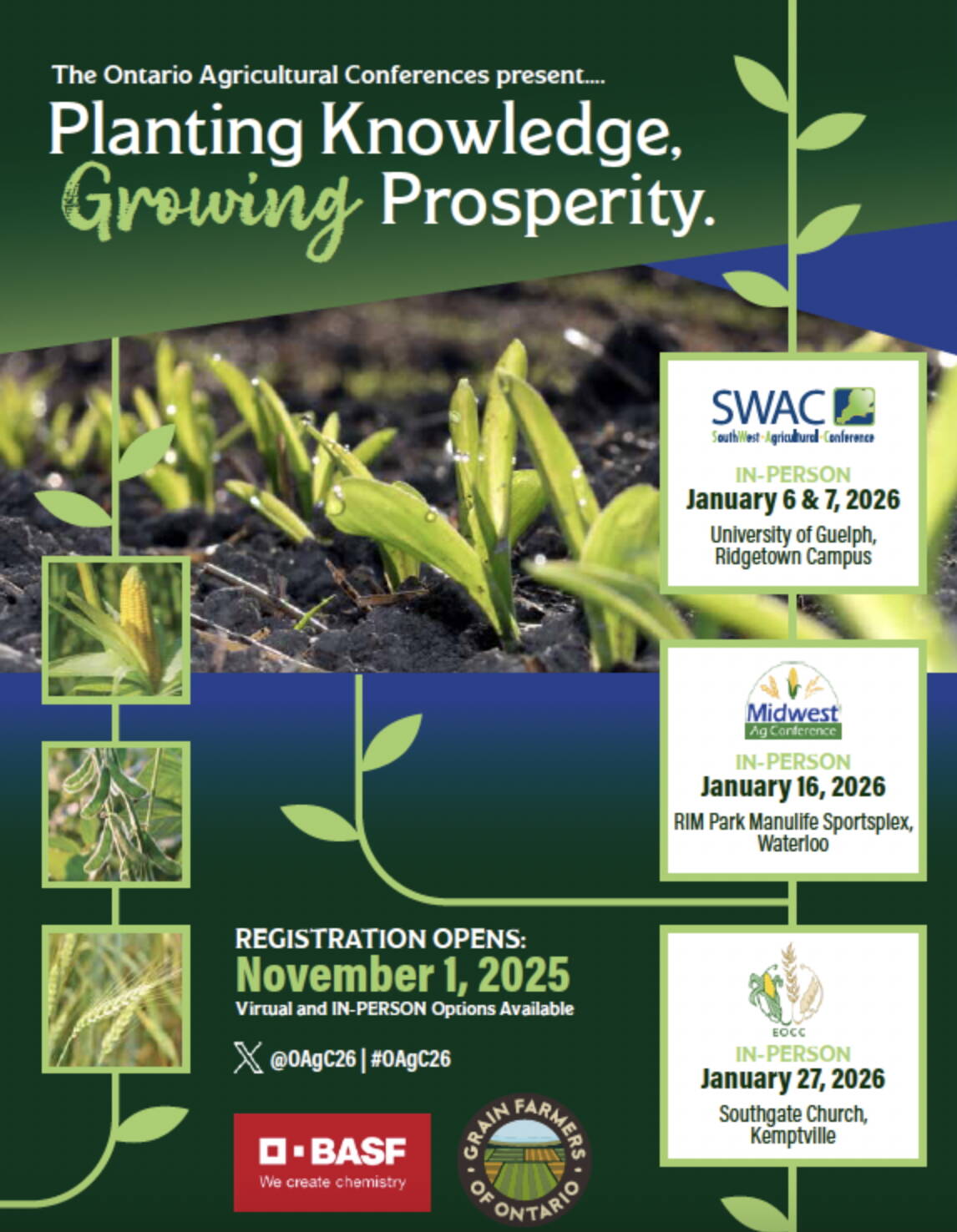Grain and oilseed markets are digesting new-crop production estimates. On April 26, Statistics Canada released the results of its acreage survey conducted between Dec. 12, 2022 and Jan. 14, 2023. Although the survey occurred two months earlier than normal, traders feel comfortable with the acreage data.
Quick look
Soybeans: Producers should be prepared for the basis deterioration in the summer.
Corn: There will be lower demand for Ontario corn in Northern Europe in the 2023-24 crop year.
Wheat: The price structure will not benefit from increased planted acreage.
During fall 2022, Ontario farmers increased winter wheat acreage by 19 per cent compared to a year earlier. This spring, soybean acres are expected to be down 5.4 per cent from last year while corn area will likely be unchanged.
Read Also

Registration open for Ontario Agricultural Conference
The Ontario Agricultural Conference 2026 offers in-person and online access to expert insights, hands-on learning, and networking opportunities.
Ontario planting progress has been delayed by 10 to 15 days. During April, Ontario received above normal precipitation and temperatures averaged one to two degrees C higher than normal. Ontario winter wheat is developing under optimal conditions, ensuring the year-over-year increase in production. Statistics Canada will release its March 31 Stocks Survey on May 9.
As of May 1, U.S. farmers had planted 26 per cent of the corn crop. This was up from last year’s progress of 13 per cent and the same as the five-year average. Soybean planting progress was 19 per cent complete, compared to seven per cent last year and the five-year average of 11 per cent.
Traders feel comfortable that row crops will be planted in a timely fashion, which usually results in trend-type yields. There is no risk premium in the futures market due to planting progress and production uncertainty.
Brazilian corn and soybean prices are sharply lower than U.S. origin. Small cargoes of Brazilian beans are trading into the U.S. As of April 26, Argentine farmers had harvested 17 per cent of the soybean crop and 15 per cent of the corn production. Brazil’s Safrinha corn crop is developing under favourable conditions, confirming record output. This comes on the heels of a record soybean harvest.
The geo-political risk premium in the wheat market continues to evaporate. Northern Hemisphere wheat production will experience a sharp year-over-year increase despite lower output in Ukraine and Russia.
The Canadian dollar continues to trade in a range with support at 73 U.S. cents and resistance at 75.5 U.S. cents. Canadian economic growth during the first half of 2023 will likely outpace that of the U.S., resulting in a stronger exchange rate for summer.
Crude oil values are up 20 per cent from the March lows and prices for copper and steel remain elevated. These are supportive factors for the resource-based currency. Natural gas prices are near historical lows, which has contributed to the sharp drop in fertilizer prices.
Soybeans
Ontario farmers are expected to plant 2.915 million acres of soybeans this spring, down 5.4 per cent or 165,000 acres from the 2022 area of 2.915 million acres. Using a traditional abandonment rate and a five-year average yield of 49 bu./acre, production has potential to reach 3.933 million tonnes, down from the 2022 output of four million tonnes.
We’re projecting Ontario on-farm stocks as of March 31 to come in at 830,000 tonnes. Ontario farmers are expected to sell 800,000 tonnes of soybeans between April 1 and Aug. 30. Seasonally, producer selling tends to decrease in April and May and increases in June and July. Commercial companies appear to have sufficient ownership to satisfy domestic and export demand.
Basis levels may hold value or increase in the short-term as farmer selling slows. However, producers should expect basis deterioration in the summer. Domestic crushers take their downtime for upgrades and maintenance during the summer. At the same time, Brazilian soybeans will saturate the world market. The U.S. soybean market is functioning to ration demand through higher prices to encourage imports.
As of April 27, Brazilian soybeans were offered at US$460/tonne f.o.b. Paranagua, down $40/tonne from 14 days earlier. U.S. soybeans were offered at $560 f.o.b. the Gulf, down $32/tonne from mid-April. Ontario soybeans are quoted at $550/tonne f.o.b. St. Lawrence, unchanged from two weeks prior.
There is no change to our U.S. or South American production estimates. Brazilian soybean production is estimated at 156 million tonnes, up from last year’s crop of 130.5 million tonnes. Argentine forecasts remain at 27 million tonnes, down from the year-ago level of 43 million tonnes. The upcoming U.S. crop has potential to reach 118-120 million tonnes, up from 2022 output of 116.4 million tonnes.
What to do: We have advised farmers to be 100 per cent sold on their 2022 output and 15 per cent sold on expected 2023 production. It’s prudent to have some sales on for new crop because there is downside potential during harvest.
Corn
According to Statistics Canada, Ontario farmers are expected to plant 2.28 million acres of corn, up only 4,000 acres from the 2022 area of 2.276 million. Using a traditional abandonment rate and a five-year average yield of 166.1 bu./acre, production has potential to finish near 9.535 million tonnes. This is up from the 2022 crop size of 9.441 and up from the five-year average output of 9.05 million tonnes.
We are forecasting the 2022-23 Ontario corn carryout at two million tonnes, up from the five-year average around 1.8 million tonnes. This ending stock projection requires exports to reach one million tonnes from April 1 through Aug. 30. Basis levels have come under pressure over the past month so Ontario corn is competitive with French origin into Northern European markets.
As of April 27, Brazilian corn was offered at $251/tonne f.o.b. Paranagua, down $37/tonne from two weeks earlier. U.S. corn was offered at $274/tonne f.o.b. the Gulf, down $21/tonne from mid-April. French corn was offered at $255/tonne f.o.b. La Pallice, unchanged from two weeks earlier. Ontario corn was offered at $250/tonne for St. Lawrence port, down $20/tonne from our previous issue.
Ontario corn is now more competitive with French and Brazilian corn into Northern Europe. U.S. corn export sales are coming in lower than expected. More importantly, China has cancelled recent sales form the U.S. and switched to Brazilian origin due to cheaper prices.
Earlier in April, we were expecting the U.S. corn crop to be planted 10-14 days behind normal. Despite the recent rains in the Midwest, there have been opportunities for farmers to advance planting progress. Traders are expecting the U.S. corn crop to finish near 385 million tonnes, up 36 million tonnes from last year.
Brazilian corn estimates remain near 125 million tonnes, up nine million tonnes from year-ago output. European corn production is expected to rebound to 65-68 million tonnes, up from the 2022 production of 52 million tonnes. Larger European corn production will result in lower demand for Ontario corn in Northern Europe in the 2023-24 crop year.
What to do: We’ve advised Ontario farmers to be 100 per cent sold on their 2022 production and 20 per cent sold on new crop. Ontario basis levels have eroded to achieve one million tonnes of exports from April 1 through Aug. 30. We’re expecting a sharp year-over-year increase in U.S. and European production. This will result in lower export demand for Ontario corn. Ontario corn output is expected to be up 500,000 tonnes from the five-year average. The summary for Ontario corn is larger supplies and lower demand.
Wheat
Statistics Canada’s winter acreage survey had Ontario winter wheat acres at 1.107 million. This was down 238,000 acres from the fall survey, which was conducted only 30-50 days earlier. Using a traditional abandonment rate and an average yield of 92 bu./acre, Ontario winter wheat production is now expected to come in at 2.7 million tonnes. This compares to last year’s output of 2.2 million tonnes and the five-year average output of 2.1 million tonnes.
Unfortunately, this lower acreage will not alter the price structure. Approximately one million tonnes will be used for domestic milling, one million will be exported and 700,000 tonnes will be used for domestic feed.
The soft red winter wheat market has found support for two main reasons. Ontario soft red winter wheat prices f.o.b. St. Lawrence port and U.S. values f.o.b. the Gulf are the lowest priced on the world market.
Secondly, in the main growing regions in the U.S., soft red winter wheat is priced competitively into the domestic feed market. The downside in Ontario soft red winter wheat prices is limited in the short term.
However, we expect to see Ontario soft red winter wheat traded into domestic feed channels during the harvest period in August. Domestic soft red winter wheat bids will be priced in line with the domestic corn market. Ontario farmers sell 80 per cent of their wheat during the first five months of the crop year.
Media reports suggest that progress is being made in negotiations to extend the Black Sea Grain Initiative beyond May 18. There are two major factors to keep in mind. There were no significant delays in past negotiations, which occurred in November 2022 and March.
Secondly, wheat prices rallied when Russia initially invaded the Ukraine in March 2022. However, there was not a significant increase in actual offshore movement from Canada or the U.S. Wheat prices eventually came down during the summer.
At the time of writing this article, the U.S. hard red winter wheat region had received timely rains with additional precipitation in the forecast. There will be some yield drag due to drier conditions earlier. We continue to project a hard red winter wheat crop in the range of 22-23 million tonnes, up from 14.4 million tonnes last year.
The U.S. soft red winter production is on track to reach 12.3 million tonnes, up 2.2 million tonnes from last year. There is no change to our European soft wheat forecast of 132 million tonnes, up six million tonnes from last year.
Ontario winter wheat prices are nearing two-year lows. During the 2022-23 crop year, the wheat market experienced a counter-seasonal pattern because prices were coming off historical highs. For 2023-24, we expect to see a traditional seasonal pattern throughout the crop year.
From a long-term perspective, the wheat market makes a seasonal high in late October or early November. The second seasonal high occurs in spring as the Northern Hemisphere crops come out of dormancy.
What to do: Earlier in April, we advised producers to be 100 per cent sold on their 2022 production. For new crop, wve don’t usually recommend sales due to quality uncertainty. Plan to store your new crop wheat until late October or early November. Wheat is one crop you need store to receive full value.















